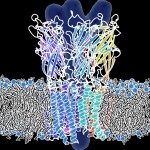Lien vers Pubmed [PMID] – 30273615
Lien vers HAL – Cliquez ici
Lien DOI – 10.1016/j.pbiomolbio.2018.09.004
Prog. Biophys. Mol. Biol. 2019 May;143:20-37
While structural data on viruses are more and more common, information on their dynamics is much harder to obtain as those viruses form very large molecular complexes. In this paper, we propose a new method for computing the coarse-grained normal modes of such supra-molecules, NormalGo. A new formalism is developed to represent the Hessian of a quadratic potential using tensor products. This formalism is applied to the Tirion elastic potential, as well as to a Gō like potential. When combined with a fast method for computing a select set of eigenpairs of the Hessian, this new formalism enables the computation of thousands of normal modes of a full viral shell with more than one hundred thousand atoms in less than 2 h on a standard desktop computer. We then compare the two coarse-grained potentials. We show that, despite significant differences in their formulations, the Tirion and the Gō like potentials capture very similar dynamics characteristics of the molecule under study. However, we find that the Gō like potential should be preferred as it leads to less local deformations in the structure of the molecule during normal mode dynamics. Finally, we use NormalGo to characterize the structural transitions that occur when FAB fragments bind to the icosahedral outer shell of serotype 3 of the Dengue virus. We have identified residues at the surface of the outer shell that are important for the transition between the FAB-free and FAB-bound conformations, and therefore potentially useful for the design of antibodies to Dengue viruses.


